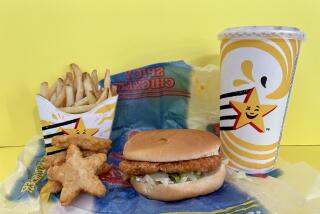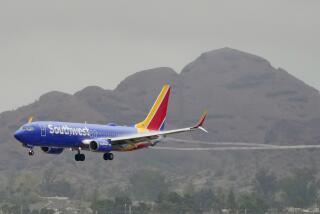Meal policies have some fliers (and their stomachs) growling
Figuring out what and even whether you’ll be fed on a flight is becoming almost impossible because the rules are complicated -- and constantly shifting. Even airlines have trouble keeping up.
Carol Scrivner of San Gabriel found herself on the losing side in the airline food fights in June when she and her husband, Joe Parker, flew Alaska Airlines from Ontario, Calif., to Seattle.
They didn’t pack a meal for their 2 1/2 -hour, 12:29 p.m. flight because their ticket documents listed “lunch.” “Lunch” turned out to be a tiny cup of vanilla ice cream, Scrivner said.
When she complained to a flight attendant, “he said, ‘We don’t do that anymore,’ snickered and walked away.” A delayed departure stretched the couple’s on-board stay to 3 1/2 hours.
When I told Scrivner’s story to Alaska Airlines spokesman Sam Sperry, he said the airline’s policy since late last year had been to serve snacks, not meals, in coach on flights of 1 1/2 to three hours long that occur during mealtimes. But the company hadn’t updated its reservation system to reflect that policy.
“This is our fault,” Sperry said. “It was clearly a mistake.”
In a flurry of industry changes, some trends have emerged: Free food and special meals are disappearing. It won’t be long before coach fliers in the U.S. will have to carry a lunchbox or cash to get what they want to eat on board -- or to get anything at all.
That’s the situation at US Airways, which ended free meals in coach on domestic flights more than a year ago. You can buy In-Flight Cafe food on most flights 700 miles or longer, said spokeswoman Amy Kudwa. A snack box costs $5, breakfast $7, lunch or dinner $10. Cash only.
Outsourcing the meals saves the airline money, Kudwa said, although predicting demand isn’t easy. As of a few months ago, about 30% of passengers bought meals, but the rate varied widely by such factors as flight length and whether the flight was at mealtime.
“Some flights you sell out; on some you have food left over,” she said. As a result, there’s no guarantee you’ll get a chance to buy food even where the program is offered, especially if you’re sitting in the last row.
US Airways, which once served 16 types of special meals, such as vegan and gluten-free, no longer offers them in coach, and starting Wednesday, it will halt them in first class too, ending all special meals on domestic flights.
“We realize this does represent an inconvenience to customers with specific dietary needs,” Kudwa said. But she said special meals were “very seldom used.”
“The cost of supplying this service and the demand from customers don’t match,” she said.
US Airways has gone further than some competitors in shrinking free food service. But the practice is widespread as cash-hungry major airlines, squeezed in the vise of high fuel costs and the low fares they must charge to compete against low-cost carriers, hunt for savings.
“What’s going on here is survival of the fittest,” Alaska’s Sperry said. “It’s down to blood and guts.”
And stomachs, apparently.
Here are some airlines that have made recent, noteworthy changes in their food policies; these apply to domestic coach flights except where otherwise stated, and exceptions are frequent:
* Alaska: A couple of years ago, the airline explained its policy as “meals at mealtimes,” except on some short flights such as those between Southern California and the Bay Area.
Now the general rule, Sperry said, is to serve a snack on flights of 1 1/2 to three hours long that occur during mealtimes; a hot entree on transcontinental flights and some others; and a sandwich at mealtimes on non-transcontinental flights that are longer than three hours. Special meals are available with notice.
* Continental: You can expect a free snack or meal on flights three hours or longer, even if the flight is outside normal meal hours, said spokeswoman Julie King. Otherwise, expect food in coach on flights of more than two hours that occur during a mealtime, such as 11 a.m. to 1 p.m. The airline runs its own on-board catering and doesn’t offer food for sale.
More than a dozen special menus are available, including Hindu, Muslim, kosher and diabetic. But last year, the airline began limiting special meals to certain flights, mostly long-haul transcontinental or foreign routes. (The list is posted at www.continental.com.)
“We look in every nook and cranny to cut costs,” King said in explaining the changes. She also noted that fewer than 5% of Continental’s passengers order special meals.
* Northwest: The airline serves free food on flights from its hubs in Detroit; Memphis, Tenn.; and Minneapolis/St. Paul to the West Coast and Hawaii (but not to the East Coast) that occur at mealtimes, also on flights from Milwaukee and Indianapolis to LAX. Special meals can be ordered. First class gets free food on flights of at least two hours that occur at mealtimes.
Meals can also be purchased for $5 to $10, cash only, on about 220 flights, up from a dozen when Northwest began the program in January 2003.
* United: For flights shorter than 3 1/2 hours, spokeswoman Robin Urbanski said, free beverages and cocktail snacks are served on United; the company’s low-cost carrier, Ted, adds some buy-on-board items such as cookies and potato chips.
On most longer flights, as long as five hours and before 8 p.m., on both United and Ted, there are no free meals, but you can buy food on board. Transcontinental flights still offer free food, including 17 special meals.
Another trend cutting a swath through airline menus is the low-carb craze. Several airlines offer low-carbohydrate entrees. Northwest has trimmed the size of bread on sandwiches.
But unless you buy food at the airport or tote your own aboard many flights, you may find yourself on a no-carb diet.
Hear more tips from Jane Engle on Travel Insider topics at www.latimes.com/engle. She welcomes comments but can’t respond individually to letters and calls. Write to Travel Insider, Los Angeles Times, 202 W. 1st St., Los Angeles, CA 90012, or e-mail jane.engle@latimes .com.
More to Read
Inside the business of entertainment
The Wide Shot brings you news, analysis and insights on everything from streaming wars to production — and what it all means for the future.
You may occasionally receive promotional content from the Los Angeles Times.










